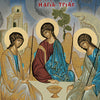The Custom of the Vasilopita in the Eastern Orthodox Church

Ever since prehistoric times people have linked all rituals - be they traditional celebrations or religious events - with food. Dozens of agricultural feasts and all religious rites, such as baptisms and funerals, are accompanied by the offering of victuals. Almost every ancient sanctuary also sports a nearby dining area, a practice that was continued by the Christian religion.
The slicing of the vasilopita could not but be the continuation of a primeval custom, that of offering bread after large agricultural celebrations, like the ancient Thesmophoria, in honor of Demeter, goddess of the harvest. In the ancient Greek Kronia festival, in honor of the god Cronus as well as in its Roman version - the Saturnalia, in honor of the god Saturn - the women of the house made sweet pies in which they placed coins. Whoever happened to get the slice with the coin was deemed “the lucky one” of the year.
This custom of the vasilopita with the coin is attributed to Saint Basil of Caesarea, who, wishing to protect his province in Cappadocia from being raided by foreign invaders, he asked all Christians to offer the most precious thing they had to the attackers to avoid being looted. The enemy, however, did not appear and the valuables were placed in small buns, one in each. And so, the small valuables or coins were redistributed randomly, to children and adults alike. These buns (pita in Greek) were named after Saint Basil (Vasileios) and hence called vasilopita. Nowadays, all cake/breads served on New Year’s Day have a coin or trinket called a flouri baked into them and lucky is the one who bites into it!





